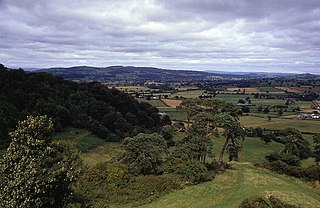The Battle of Nantwich was fought on 25 January 1644 in Cheshire during the First English Civil War. In the battle, Sir Thomas Fairfax in command of a Parliamentarian relief force defeated Lord Byron and the Royalists.

Chirk Castle is a Grade I listed castle located in Chirk, Wrexham County Borough, Wales, 1.5 mi (2.4 km) from Chirk railway station, now owned and run by the National Trust.

Sir Thomas Myddelton (1586–1666) of Chirk Castle, Denbighshire, was an English-born Welsh landowner, politician, and military officer. He became a Member of Parliament in 1624; during the First English Civil War he was a prominent Parliamentarian general, despite having no previous military experience.
Sir Thomas Myddelton was a Welsh merchant who was Lord Mayor of London before becoming a Member of Parliament for London.
The First Battle of Middlewich took place on 13 March 1643, during the First English Civil War, and was fought between the Parliamentarians, under Sir William Brereton, and the Royalist supporters of King Charles I of England, under Sir Thomas Aston.

The Second Battle of Middlewich took place on 26 December 1643 near Middlewich in Cheshire during the First English Civil War. A Royalist force under Lord Byron defeated a Parliamentarian army commanded by Sir William Brereton.

Sir Thomas Salusbury, 2nd Baronet was a Welsh poet, politician and soldier, who supported King Charles I in English Civil War and was a colonel of a Royalist regiment.

Sir William Vaughan was a cavalry officer in the armies of Charles I of England. Initially serving in Ireland during the Confederate Wars, the outbreak of the First English Civil War led to him being sent to England in 1644, at the head of an Anglo-Irish cavalry regiment, to reinforce the Royalist army.

Major General Thomas Mytton, also spelt Mitton,, was a lawyer from Oswestry who served in the Parliamentarian army during the Wars of the Three Kingdoms and as MP for Shropshire in the First Protectorate Parliament.

Sir Richard Myddelton, 3rd Baronet, of Chirk Castle, Denbighshire, was a Welsh landowner and Tory politician who sat in the House of Commons from 1685 to 1716.

George Twisleton, 1618 to 12 May 1667, was a member of the landed gentry from Yorkshire and colonel in the Parliamentarian army during the Wars of the Three Kingdoms. Under the Commonwealth of England, he sat as MP for Anglesey from 1654 to 1659.
This is a timeline for the English Civil War in Shropshire.

The Battle of Montgomery took place during the First English Civil War of 1642–1646. On 17 September 1644, a Parliamentarian force commanded by Sir John Meldrum advanced to engage a Royalist army led by Lord Byron which was besieging Montgomery Castle in mid Wales. The battle was fought the next day. After the Royalists gained an initial advantage, the Parliamentarians counter-attacked and destroyed Byron's army.

Colonel Robert Myddelton Biddulph was a British landowner and Member of Parliament for the Liberal Party.

Sir John Owen of Clenennau, was a Welsh landowner from Anglesey, who served with the Royalist army in the Wars of the Three Kingdoms, during which he held various commands in North Wales.

The Battle of Oswestry took place during the First English Civil War on 22–23 June 1644 when Parliamentarians led by Lord Denbigh attacked and took control of the Royalist garrison in Oswestry, Shropshire.

The Battle of Denbigh Green took place during the closing stages of the First English Civil War. Fought just outside the Royalist garrison of Denbigh, it has been described as probably the only action in the North Wales theatre of the war "meriting the description of battle".

The Battle of Y Dalar Hir took place on 5 June 1648 in Caernarfonshire, North Wales, during the Second English Civil War. While little more than a skirmish, it had a significant effect on the local progress of the conflict.

Sir Edward Broughton was a Welsh landowner and soldier with a long service in Royalist armies during the Wars of the Three Kingdoms. Imprisoned in the Gatehouse Prison in Westminster in 1659 following a Royalist rebellion, he later married the prison keeper's widow and took on the lease of the prison himself.
The Denbighshire Militia, later the Royal Denbighshire Rifles was an auxiliary regiment reorganised in the Welsh county of Denbighshire during the 18th Century from earlier precursor units. Primarily intended for home defence, it provided a contingent for service in France in the closing stages of the Napoleonic War. After a series of short-lived mergers with other Welsh militia regiments it became part of the Royal Welsh Fusiliers, It served as a Special Reserve training unit in World War I. After 1921 the militia had only a shadowy existence until its final abolition in 1953.















